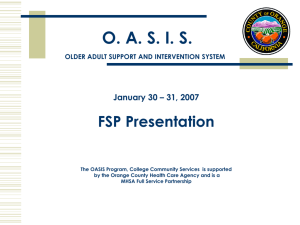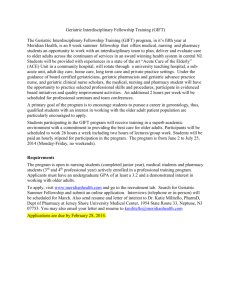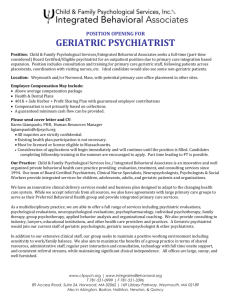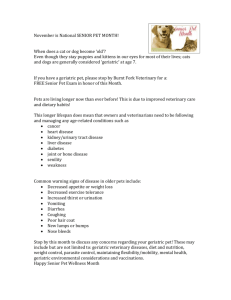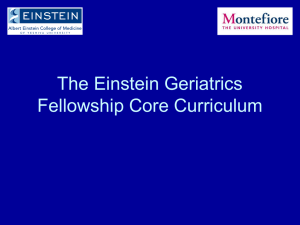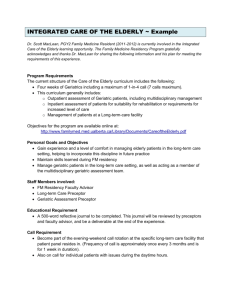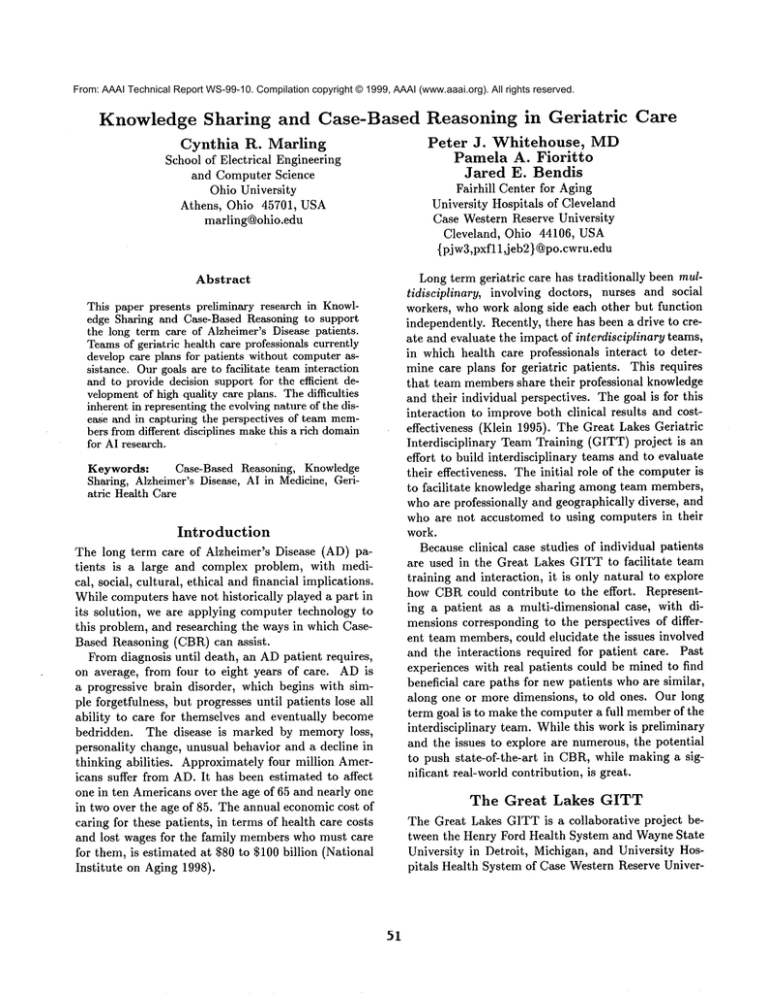
From: AAAI Technical Report WS-99-10. Compilation copyright © 1999, AAAI (www.aaai.org). All rights reserved.
Knowledge Sharing
and Case-Based
Cynthia
R. Marling
School of Electrical Engineering
and Computer Science
Ohio University
Athens, Ohio 45701, USA
marling@ohio.edu
Reasoning
in Geriatric
Care
Peter
J. Whitehouse,
MD
Pamela A. Fioritto
Jared
E. Bendis
Fairhill Center for Aging
University Hospitals of Cleveland
Case Western Reserve University
Cleveland, Ohio 44106, USA
{pjw3,pxfll,jeb2)@po.cwru.edu
Long term geriatric care has traditionally been multidisciplinary,
involving doctors, nurses and social
workers, who work along side each other but function
independently. Recently, there has been a drive to create and evaluate the impact of interdisciplinary teams,
in which health care professionals interact to determine care plans for geriatric patients. This requires
that team members share their professional knowledge
and their individual perspectives. The goal is for this
interaction to improve both clinical results and costeffectiveness (Klein 1995). The Great Lakes Geriatric
Interdisciplinary
TeamTraining (GITT) project is
effort to build interdisciplinary teams and to evaluate
their effectiveness. The initial role of the computeris
to facilitate
knowledge sharing among team members,
who are professionally and geographically diverse, and
who are not accustomed to using computers in their
work.
Because clinical case studies of individual patients
are used in the Great Lakes GITT to facilitate
team
training and interaction, it is only natural to explore
how CBRcould contribute to the effort. Representing a patient as a multi-dimensional case, with dimensions corresponding to the perspectives of different team members, could elucidate the issues involved
and the interactions required for patient care. Past
experiences with real patients could be mined to find
beneficial care paths for new patients whoare similar,
along one or more dimensions, to old ones. Our long
term goal is to make the computer a full memberof the
interdisciplinary team. While this work is preliminary
and the issues to explore are numerous, the potential
to push state-of-the-art
in CBR, while making a significant reM-worldcontribution, is great.
Abstract
This paper presents preliminary research in Knowledge Sharing and Case-Based Reasoning to support
the long term care of Alzheimer’s Disease patients.
Teamsof geriatric health care professionals currently
develop care plans for patients without computerassistance. Our goals are to facilitate team interaction
and to provide decision support for the efficient developmentof high quality care plans. The difficulties
inherent in representing the evolvingnature of the disease and in capturing the perspectives of team members from different disciplines makethis a rich domain
for AI research.
Keywords:
Case-Based Reasoning, Knowledge
Sharing, Alzheimer’s Disease, AI in Medicine, Geriatric Health Care
Introduction
The long term care of Alzheimer’s Disease (AD) patients is a large and complex problem, with medical, social, cultural, ethical and financial implications.
While computers have not historically played a part in
its solution, we are applying computer technology to
this problem, and researching the ways in which CaseBased Reasoning (CBR) can assist.
From diagnosis until death, an ADpatient requires,
on average, from four to eight years of care. ADis
a progressive brain disorder, which begins with simple forgetfulness, but progresses until patients lose all
ability to care for themselves and eventually become
bedridden. The disease is marked by memory loss,
personality change, unusual behavior and a decline in
thinking abilities.
Approximately four million Americans suffer from AD. It has been estimated to affect
one in ten Americans over the age of 65 and nearly one
in two over the age of 85. The annual economic cost of
caring for these patients, in terms of health care costs
and lost wages for the family members who must care
for them, is estimated at $80 to $100 billion (National
Institute on Aging 1998).
The
Great
Lakes
GITT
The Great Lakes GITTis a collaborative project between the Henry Ford Health System and WayneState
University in Detroit, Michigan, and University Hospitals Health System of Case Western Reserve Univer-
51
as presented in (Fisher, Kopelman, ~ Schneider 1994;
Fisher & Ury 1981); and using the "fifth discipline"
communications protocols for improved advocacy, inquiry and conflict resolution, as in (Senge 1990; Senge
et al. 1994). The GITTWebsite provides participants
with synopses of team building strategies, references to
books and articles which elaborate on the strategies,
and opportunities to practice the strategies in addition
to those provided by in-person team meetings.
sity, Cleveland State University’s Departmentof Social
Work, and the Benjamin Rose Institute in Cleveland,
Ohio. It is one of eight national GITTprojects, which
are described in (Siegler et al. 1998). The Great Lakes
GITTdiffers from other GITTprojects in its inclusion
of participants from two different cities, its use of the
learning teams model (Senge 1990), and its extensive
use of computers. The purpose of GITT is to train
current and future health care practitioners to work in
interdisciplinary teams to provide care to elders. Most
participants are from the disciplines of medicine, nursing and social work, but participants from pharmacy,
rehabilitation,
nutrition and administration may also
be included.
Great Lakes GITT participants
have access to a
password-protected Website which provides information on geriatric care and interdisciplinary teamwork,
as well as a communications forum. Online resources
include: a chat room for interactive conversation, bulletin boards for posting discussion topics, calendars for
arranging meetings, team directories, a library focusing on the ethical aspects of AD,case studies of geriatric syndromes, pointers on effective teamwork, storyboards for showcasing team efforts, and pointers to
selected geriatric sites across the Web.
Knowledge
The Role
of
Cases
Clinical case studies of geriatric patients are used
to facilitate
team interaction and knowledge sharing
in GITT. A case represents a prototypical patient
and is based on one or more actual patients.
Each
case is a textual description, presented in discrete
episodes, interspersed with discussion questions. Although the cases are presented online, they are in a
human readable, rather than a machine processable,
format. Groups of participants
review a case, one
episode at a time, and discuss the questions between
episodes. Questions may lead to development of a care
plan and/or to an elaboration of relevant issues. Not
all questions have right answers and not all outcomes
are observable, mirroring the situation in real-world
geriatric care. Knowledgegained, from the content of
the case and from the interaction of discussion, is to
be transferred manually by participants to situations
they encounter in clinical practice.
Four cases are currently available to GITTparticipants. Each one took between 30 and 40 hours of
effort to develop. Rather than presenting manycases,
the emphasis is on developing and presenting exactly
the right case to illustrate a geriatric syndrome. This
is consistent with case presentation as used in problembased learning for medical education (Barrows &z Tamblyn 1980).
Weare currently investigating how we can expand
the role of the case. A traditional
CBRuse would
be to automatically use the existing cases to suggest
questions to ask and/or treatment plans to follow for
similar patients in the future. Thoughthe use is traditional, new issues would need to be resolved, due to
the difficulty of representing a patient over time and
recognizing similarities at different stages of disease.
For one thing, a patient in the early stages of ADis
not at all similar to himself in later stages. Furthermore, the disease progresses at different rates and in
different ways in different patients. Differences may
be due to the individual patient, the patient’s environment, and/or the interventions prescribed by health
care professionals for the patient’s care. Because AD
can not be prevented or cured, it is important to recog-
Sharing
Although long term geriatric care requires the integration of a broad range of clinical and social interventions, as well as the ability to reconfigure services
quickly as patient needs change, there is a history
of not sharing knowledgeeffectively across disciplines
(Drinka & Streim 1994). Not sharing knowledge may
lead to missed opportunities and/or conflict. For example, a social worker might immediately recognize
that a community elder care program would benefit
a particular patient, while a doctor or nurse seeing
the same patient might not make the same connection.
The opportunity to help the patient could be missed or
delayed. Interventions might conflict, for example, if
the level of medication leaves a patient too sedated or
too agitated to fully participate in a communityprogram. Professionals might conflict with each other as
well, if they see equally compelling but different aspects of a case and believe only their own perspectives
to be valid.
Strategies used to share knowledge in ways that
maximize opportunity and minimize conflict are not
specific to geriatric care, but are used to promoteeffective teamworkin any organization. Approaches used in
GITTinclude: recognizing and incorporating the components of highly effective teamwork, as described in
(Scholtes 1988); using tools for conflict management,
52
nize and prescribe interventions which are most likely
to slow the progression of the disease.
An innovative use of CBRmight be to use the cases
to illustrate the principles of GITTthrough cognitive
modeling. The first step in using cases, for any CBR
application, is to derive a structured representation
for a case. AD cases have not only the dimension
of time, but also the dimension of perspective. Doctors, nurses and social workers view patients in different ways, which is why it is important for them
to work together to begin with. These perspectives
must be maintained for accurate case representation,
so perhaps they could be leveraged through controlling the amount of weight, or influence, given to each
perspective. Then, the doctor who never listens to
nurses could be modeled by setting the nurse perspective weights to zero. Perspectives could be added one
at a time to see the effect on the care plan. This would
not only serve as a training tool for GITTparticipants,
but would also provide a building block for the more
traditional application.
Related
Research
The medical domain has provided fertile ground for
CBRresearch ever since CASEY(Koton 1988), which
diagnosed problems in heart failure patients, and PROTOS(Bareiss 1989), which diagnosed audiological disorders. While early CBRin Medicine systems focused on diagnosis, later systems have addressed a
broad range of tasks. ProtoISIS offers decision support to primary care physicians in the selection of diagnostic imaging procedures (Kahn & Anderson 1994).
ROENTGEN
supports the design of radiation
therapy plans (Berger 1994). McRadprovides radiological
expertise in the form of reference images to support
patient evaluation (Macura & Macura 1995). ICONS
provides advice on antibiotic therapy in intensive care
medicine (Heindl et al. 1997).
At least two factors differentiate our work from previous CBRin Medicine research. First,
AD cases
evolve over a period of years. Each case encompasses
a series of problems, interventions and outcomes, any
of which could be relevant to future cases. Second,
the knowledge needed to plan interventions and predict outcomesfor a single patient resides with multiple
health care professionals, whohave different, possibly
conflicting perspectives, which must be reconciled and
combined. Any of these professionals may want to use
our system to augment their own knowledge with the
perspectives of others.
In somerespects, the prior work most closely related
to our own is that reported by (Bradburn ~ Zeleznikow
1994). They prototyped an advisory system named
FLORENCEin the domain of nursing care. FLORENCEassists nurses with the tasks of nursing diagnosis, prognosis and prescription, by extrapolating
results observed in earlier patients to later ones. As
in our work, FLORENCE
aims to recommend interventions having the greatest likelihood of success. It
begins to tackle the issue of temporal cases, in that a
patient’s progress may be followed for up to ten days.
Unlike our work, FLORENCE
deals with short term
care and assumes that nurses operate independently of
other health care professionals.
Because the Great Lakes GITTinvolves training, educational CBRsystems, like those fielded by the Institute for the Learning Sciences, are also relevant to
our work (Schank 1998). The ASKsystems, like ASK
Tom(Ferguson et al. 1992), are related in that questions form an integral part of each geriatric case. The
Sickle Cell Counsellor (Bell, Bareiss, &Beckwith 1994)
resonates for ADpractitioners,
because genetics and
genetic counseling are important in working with AD
patients and their families (Post &5 Whitehouse1998).
In this museum-basedsystem, goal based scenarios engage users as role-playing counselors to virtual carriers
of the sickle cell gene. Unlike museum-goers, whose
role-playing serves to motivate their learning, GITT
participants counsel people professionally within the
roles defined by their disciplines.
Future
Work
Our immediate goal is to complete the representation
of an ADpatient as a structured case which encompasses dimensions of time and perspective. Next, we
plan to field prototype systems for GITTparticipants
which use these cases for clarifying perspectives and
for decision support. Wewill focus first on the fundamental post-diagnostic decisions which must be made,
such as which medications to prescribe. Our aim is to
provide mixed-initiative
human/computer reasoning,
via the cases, to movethe computer closer to being a
real and productive memberof the geriatric interdisciplinary team. Wewill continue exploring issues of case
organization, case similarity over time, and the cognitive processes involved in team dynamics and geriatric
care planning. It is our hope, that due to the richness
and complexity of our problem domain, many unanticipated AI and geriatric issues will arise to challenge
and inspire our research.
Summary
and
Conclusions
Wepresent preliminary research in knowledge sharing
and case-based reasoning in geriatric care. While computers have not been used previously in the long term
care of ADpatients, we are using them to facilitate
53
Fisher, R.; Kopelman, E.; and Schneider, A. K. 1994.
Beyond Machiavelli: Tools for Coping with Conflict.
Cambridge, MA:Harvard University Press.
knowledgesharing in geriatric interdisciplinary teams.
Weare investigating how CBRcan more actively support health care practitioners in planning long term
care, changing the role of the computer towards that
of a virtual team member. This problem provides not
only a rich context in which to conduct AI research,
but also the potential for real-world impact.
Heindl, B.; Schmidt, R.; Schmidt, G.; Haller, M.;
Pfaller, P.; Gierl, L.; and Pollwein, B. 1997. A
case-based consilarius for therapy recommendation
(ICONS): Computer-based advice for calculated antibiotic therapy in intensive care medicine. Computer
Methods and Programs in Biomedicine 52:117-127.
Acknowledgements
The Great Lakes GITT project is funded by the John
A. Hartford Foundation, Inc., of New York and the
Cleveland Foundation. Wewould like to thank Joann
Castle, Shirley Moore, Julia Rajcan, Marybeth Tupper, Nancy Wadsworth, Nancy Whitelaw, John Wisniewski, and the GITTparticipants for contributions
to this work.
Kahn, C. E., and Anderson, G. M. 1994. Case-based
reasoning and imaging procedure selection. Investigative Radiology 29:643-647.
Klein, S., ed. 1995. A National Agenda for Geriatric Education: White Papers. Rockville, MD:US
Department of Health and Human Services, Health
Resources and Services Administration, Bureau of
Health Professions.
References
Bareiss, R. 1989. Exemplar-Based Knowledge Acquisition: A Unified Approach to Concept Representation, Classification,
and Learning. San Diego, CA:
Academic Press.
Koton, P. 1988. Reasoning about evidence in causal
explanations. In Proceedings AAAI-88, 256-261. San
Mateo, CA: Morgan Kaufmann.
Macura, R. T., and Macura, K. J. 1995. McRad: Radiology image resource with a case-based retrieval system. In Veloso, M., and Aamodt, A., eds., Case-Based
Reasoning Research and Development: First International Conference, Proceedings ICCBR-95, 43-54.
Berlin: Springer-Verlag.
Barrows, H. S., and Tamblyn, R. M. 1980. ProblemBased Learning: An Approach to Medical Education.
NewYork, NY: Springer.
Bell, B.; Bareiss, R.; and Beckwith, R. 1994. Sickle
cell counselor: A prototype goal-based scenario for
instruction in a museumenvironment. Technical Report 56, The Institute
for the Learning Sciences,
Evanston, IL.
National Institute on Aging. 1998. Progress Report on
Alzheimer’s Disease, 1998. Bethesda, MD:National
Institutes of Health. NIHPublication No. 99-3616.
Berger, J. 1994. Roentgen: Radiation therapy and
case-based reasoning. In Proceedings of the Tenth
Conferenceon Artificial Intelligence for Applications.
Los Alamitos, CA: IEEE Computer Society Press.
Post, S., and Whitehouse, P. J., eds. 1998. Genetic
Testing for Alzheimer Disease: Ethical and Clinical
Issues. Baltimore, MD: Johns Hopkins University
Press.
Bradburn, C., and Zeleznikow, J. 1994. The application of case-based reasoning to the tasks of health
care planning. In Wess, S.; Althoff, K. D.; and
Richter, M. M., eds., Topics in Case-Based Reasoning: First European Workshop, 365-378. Berlin:
Springer-Verlag.
Schank, R. C., ed. 1998. Inside Multi-Media Case
Based Instruction. Mahwah, N J: Erlbaum.
Scholtes, P. R. 1988. The Team Handbook: How to
Use Teams to Improve Quality. Madison, WI: Joiner.
Senge, P.; Ross, R.; Smith, B.; Roberts, C.; and
Kleiner, A. 1994. The Fifth Discipline Fieldbook:
Strategies and Tools for Building a Learning Organization. New York, NY: Doubleday.
Drinka, T. J. K., and Streim, J. E. 1994. Case
studies from purgatory: Maladaptive behavior within
geriatrics
health care teams. The Gerontologist
34(4):541-547.
Senge, P. M. 1990. The Fifth Discipline: The Art
and Practice of the Learning Organization. NewYork,
NY: Doubleday.
Ferguson, W.; Bareiss, R.; Birnbaum, L.; and Osgood, R. 1992. Ask systems: An approach to the realization of story-based teachers. Technical Report 22,
The Institute for the Learning Sciences, Evanston, IL.
Siegler, E.; Hyer, K.; Fulmer, T.; and Mezey,M., eds.
1998. Geriatric Interdisciplinary TeamTraining. New
York, NY: Springer.
Fisher, R., and Ury, W. 1981. Getting to Yes: Negotiating Agreement without Giving In. Boston, MA:
Houghton Mifflin.
54


